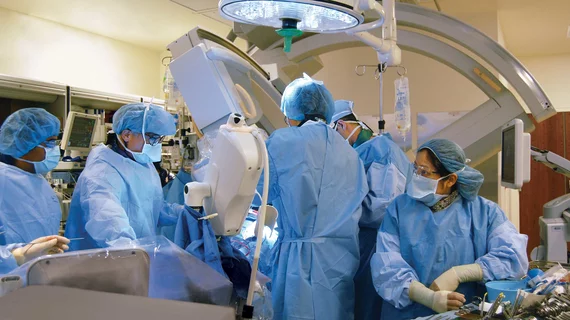TAVR complication rates keep falling, highlighting considerable progress
Complications after transcatheter aortic valve replacement (TAVR) and surgical aortic valve replacement (SAVR) have decreased dramatically in recent years, according to new findings published in the Journal of the American Heart Association.[1]
The analysis, based on data from more than 200,000 U.S. patients, highlighted the fact that TAVR has been linked to a much more significant drop in complications than SAVR.
“The introduction of TAVR has profoundly changed the management of patients with aortic stenosis (AS), and TAVR has now surpassed SAVR in terms of annual procedural volume in the United States,” wrote first author James E. Harvey III, MD, MSc, a cardiologist with WellSpan in York, Pennsylvania, and colleagues. “Although both treatment modalities remain fundamental therapeutic approaches to patients with AS, over the past decade, there have been considerable improvements in TAVR, including advances in procedural technique, device technologies, and patient selection. In contrast, the procedural and technological aspects of SAVR have remained more constant given that it is a more mature procedure with a well‐established track record and historically excellent outcomes. Although previous studies have explored the impact of treatment evolution on short‐ and long‐term mortality, contemporary evidence is lacking on the changes in complications between TAVR and SAVR.”
Harvey et al. tracked fee-for-service Medicare data from 211,212 patients who underwent elective aortic valve replacement—TAVR or SAVR—from 2012 to 2019. The group stopped its analysis in 2019 so that it did not have to weigh the potential impact of the COVID-19 pandemic on patient outcomes. The mean age of the cohort was 78.6 years old, and 55% of patients were men.
For this study, complications were defined as any cases of new-onset atrial fibrillation, acute kidney injury, acute myocardial infarction, aortic rupture, hemorrhage, postoperative infection, pacemaker implantation, prolonged ventilation, respiratory failure, septicemia, stroke, vascular complications or all-cause mortality up to 30 days following treatment.
Overall, the complication rate for aortic valve replacement dropped from 49% in 2012 all the way to 22% in 2019. Looking at each treatment option separately, complications after TAVR were seen in 41% of patients in 2012 and 19% in 2019. The complication rate after SAVR, meanwhile, dropped from 51% in 2012 to 47% in 2019.
These improvements are likely related to several factors, the group explained.
“The introduction of TAVR has enabled clinicians to optimize patient selection in terms of preferred aortic valve replacement technique based on the patient's underlying anatomy,” they wrote. “For example, patients harboring porcelain aortas, hostile chest reentry, or poor pulmonary reserve may be considered more suitable for TAVR than for SAVR. Conversely, patients with excessive left ventricular outflow tract calcification, small annuli, or low‐lying coronary arteries are often more suitable for SAVR than TAVR. Additionally, mandatory reporting of TAVR‐ and SAVR‐related outcomes to national data repositories has helped to drive improvements in techniques and outcomes across the United States.”
Click here to read the full study.

